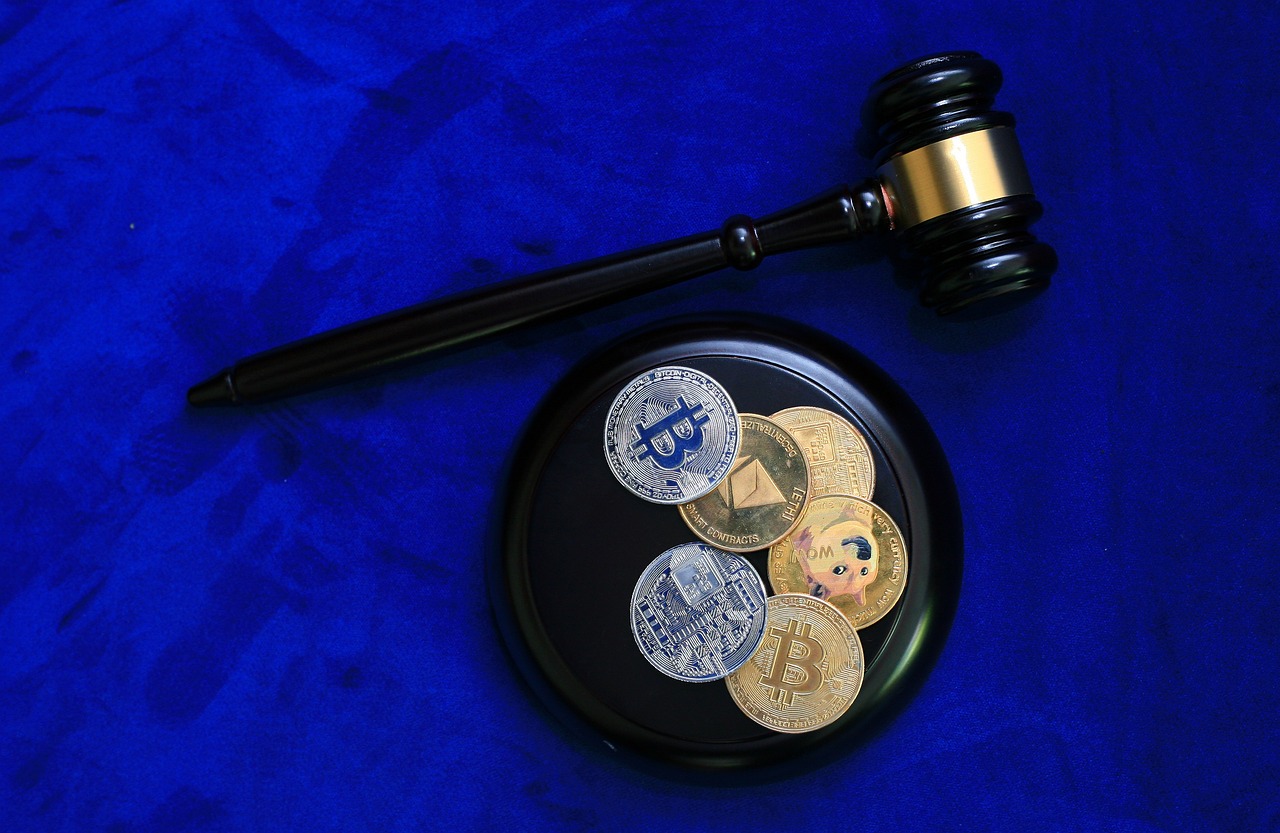The Importance of Legal Compliance in Blockchain Technology
In today's rapidly evolving digital landscape, legal compliance has emerged as a cornerstone for the successful deployment and operation of blockchain technology. As organizations worldwide are beginning to embrace this revolutionary technology, understanding the legal framework that governs blockchain is not just advisable—it's essential. The implications of non-compliance can be severe, leading to hefty fines, legal repercussions, and a tarnished reputation that could take years to rebuild. So, why is legal compliance so critical in the blockchain space? Let's dive into this intricate world and explore its significance for businesses, users, and regulatory bodies alike.
At its core, blockchain technology is celebrated for its decentralized nature, which allows for peer-to-peer transactions without the need for intermediaries. This feature not only enhances efficiency but also reduces costs. However, this very decentralization complicates the legal landscape, as traditional regulatory frameworks often struggle to keep pace with technological advancements. As a result, businesses must navigate a complex maze of regulations that vary by jurisdiction, making it imperative to stay informed and compliant.
Furthermore, the potential applications of blockchain technology are vast, spanning industries such as finance, healthcare, supply chain, and even entertainment. Each of these sectors has its own set of legal requirements, which means that a one-size-fits-all approach to compliance simply won't cut it. For instance, while a blockchain solution in finance may need to adhere to stringent anti-money laundering (AML) and know your customer (KYC) regulations, a healthcare application might focus more on data protection laws to safeguard patient information.
The stakes are high, and the consequences of ignoring legal compliance can be catastrophic. Not only can businesses face legal action, but they can also lose the trust of their users, which is invaluable in the digital age. Imagine investing your time and resources into a blockchain project, only to have it shut down due to regulatory violations. It's a nightmare scenario that underscores the need for a proactive approach to compliance.
As we delve deeper into the article, we will explore the existing legal frameworks that govern blockchain technology, the roles of regulatory bodies, and the challenges businesses face in achieving compliance. We will also provide best practices and actionable strategies to help organizations navigate this complex regulatory environment effectively. By the end of this article, you will have a clearer understanding of why legal compliance is not just a checkbox to tick off but a vital component of successful blockchain implementation.
- Why is legal compliance important in blockchain technology? Legal compliance ensures that blockchain projects operate within the law, avoiding fines and legal issues while building trust with users.
- What are the main regulations affecting blockchain? Key regulations include financial regulations like AML and KYC, as well as data protection laws such as GDPR.
- How can businesses ensure compliance? Organizations can implement compliance programs, continuously monitor regulations, and adapt their practices as needed.

Understanding Blockchain Technology
Blockchain technology, at its core, is a revolutionary way of storing and sharing data. Imagine a digital ledger that is not only decentralized but also tamper-proof. This means that once data is entered, it cannot be altered without the consensus of the network. Think of it like a public library where every book is a record, and once a book is placed on the shelf, it cannot be removed or changed without everyone knowing. This fundamental principle of transparency and security is what makes blockchain so appealing across various sectors.
The decentralized nature of blockchain is one of its most intriguing features. Traditional databases are controlled by a central authority, which can be a single entity or organization. In contrast, blockchain operates on a peer-to-peer network where every participant has access to the entire database. This not only enhances security but also eliminates the risk of a single point of failure. In a world where data breaches and cyber threats are rampant, this decentralization acts as a fortress, protecting sensitive information from malicious attacks.
Blockchain technology has a wide array of applications that extend far beyond cryptocurrencies. For instance, in supply chain management, it can provide real-time tracking of goods, ensuring that every step from production to delivery is transparent and verifiable. In healthcare, it can securely store patient records, giving patients control over who accesses their information. The potential is vast, and as industries begin to understand and adopt blockchain, we are likely to see innovations that we can't even imagine today.
However, to fully harness the power of blockchain, understanding its operational mechanics is crucial. Each block in a blockchain contains a list of transactions, a timestamp, and a reference to the previous block, creating a chain of blocks—hence the name. This structure not only ensures data integrity but also makes it extremely difficult for anyone to manipulate the data without detection. The consensus mechanism, whether it's proof of work, proof of stake, or another method, ensures that all participants agree on the state of the blockchain, further enhancing its reliability.
In conclusion, blockchain technology is not just a passing trend; it represents a paradigm shift in how we think about data storage and sharing. Its decentralized nature, combined with robust security features, positions it to transform industries. As we continue to explore the vast potential of blockchain, it is essential to understand not only its capabilities but also the legal frameworks that will govern its use. This understanding will ensure that businesses can navigate the complexities of this technology while remaining compliant with existing regulations.
- What is blockchain technology? Blockchain technology is a decentralized digital ledger that securely records transactions across a network of computers.
- How does blockchain ensure data security? Blockchain uses cryptographic techniques and consensus mechanisms to ensure that once data is recorded, it cannot be altered without the agreement of the network.
- What are some applications of blockchain? Blockchain can be used in various fields, including finance, supply chain management, healthcare, and voting systems.
- Why is legal compliance important in blockchain? Legal compliance is crucial to ensure that blockchain applications operate within the law, protecting businesses from legal repercussions and fostering trust with users.

Legal Frameworks Governing Blockchain
As blockchain technology continues to evolve, understanding the legal frameworks that govern its use is essential for businesses and users alike. The legal landscape surrounding blockchain is complex and varies significantly across different jurisdictions. This complexity arises from the need to balance innovation with the necessity of regulatory compliance, ensuring that the technology can be utilized safely and effectively. Countries around the world are grappling with how to regulate blockchain technology, leading to a patchwork of laws and regulations that can be challenging to navigate.
At the national level, many governments are beginning to establish specific regulations that address the unique characteristics of blockchain. These regulations often focus on aspects such as cryptocurrency transactions, smart contracts, and the use of decentralized applications (dApps). For instance, some countries have implemented licensing requirements for cryptocurrency exchanges, while others have taken a more hands-off approach, allowing the technology to develop organically. This disparity can create confusion for businesses operating in multiple jurisdictions, as they must comply with a variety of legal standards.
Internationally, organizations such as the Financial Action Task Force (FATF) are working to create guidelines that promote consistency in how countries regulate blockchain technology. These guidelines often emphasize the importance of anti-money laundering (AML) and know your customer (KYC) practices, which are crucial for maintaining the integrity of financial systems. The FATF's recommendations encourage countries to adopt similar regulatory frameworks, which can help facilitate cross-border transactions and enhance the legitimacy of blockchain-based businesses.
In addition to financial regulations, blockchain technology must also contend with various data protection laws. For example, the General Data Protection Regulation (GDPR) in the European Union imposes strict requirements on how personal data is collected, stored, and processed. This has significant implications for blockchain, particularly because of its immutable nature. Businesses must find ways to comply with these regulations while still leveraging the benefits of blockchain technology. This often requires innovative solutions that balance the need for data privacy with the transparency and security that blockchain offers.
Moreover, the evolving nature of technology means that legal frameworks must also adapt. Regulatory bodies are continually assessing the impact of blockchain on existing laws and are often slow to respond to the rapid pace of innovation. This can create a situation where businesses find themselves in a legal gray area, unsure of how to proceed. As such, staying informed about legal developments and actively engaging with regulatory bodies is crucial for companies operating in the blockchain space.
In summary, the legal frameworks governing blockchain technology are multifaceted and constantly changing. Companies must remain vigilant and proactive in understanding these regulations to ensure compliance and avoid potential legal pitfalls. By doing so, they can harness the full potential of blockchain while mitigating risks associated with non-compliance.
- What are the primary legal challenges facing blockchain technology?
The primary challenges include regulatory uncertainty, compliance with data protection laws, and navigating the varying legal frameworks across different jurisdictions.
- How can businesses ensure compliance with blockchain regulations?
Businesses can ensure compliance by staying informed about relevant laws, implementing robust compliance programs, and engaging with legal experts to navigate the complex regulatory landscape.
- Are there international standards for blockchain regulation?
While there are guidelines from organizations like the FATF, there is currently no comprehensive international standard for blockchain regulation. Each country tends to develop its own framework.

Regulatory Bodies and Their Roles
When it comes to the world of blockchain technology, understanding the regulatory landscape is crucial. Regulatory bodies play a pivotal role in shaping how blockchain operates, ensuring that it aligns with existing laws and protects the interests of users and investors alike. These organizations are tasked with not only enforcing compliance but also providing guidance on best practices, which can sometimes feel like navigating a maze without a map. So, who are these key players in the regulatory arena, and what do they do?
At the forefront, we have national regulatory authorities, which vary from country to country. For instance, in the United States, the Securities and Exchange Commission (SEC) is responsible for overseeing securities, including those related to cryptocurrencies and tokens. In contrast, the Commodity Futures Trading Commission (CFTC) regulates futures and options markets, which can include certain digital assets. Meanwhile, in Europe, the European Securities and Markets Authority (ESMA) plays a similar role, ensuring that financial markets function effectively and transparently.
Beyond national boundaries, we also see international organizations stepping in. The Financial Action Task Force (FATF), for example, sets global standards to combat money laundering and terrorist financing, which directly impacts how blockchain companies operate. Their guidelines push jurisdictions to implement regulations that require blockchain entities to comply with Anti-Money Laundering (AML) and Know Your Customer (KYC) protocols, thereby enhancing accountability within the blockchain ecosystem.
Each regulatory body has its own set of responsibilities, which can be summarized as follows:
- Monitoring Compliance: Ensuring that blockchain companies adhere to laws and regulations.
- Guidance and Support: Providing frameworks and guidelines to help businesses understand their obligations.
- Enforcement Actions: Taking action against entities that violate regulations, which can include fines or sanctions.
- Consumer Protection: Safeguarding user interests and promoting transparency in blockchain operations.
However, the roles of these regulatory bodies are not without challenges. The rapid pace of technological innovation often outstrips the ability of regulators to keep up, leading to a situation where laws may become outdated or ambiguous. This can create uncertainty for businesses trying to navigate compliance requirements. Additionally, the decentralized nature of blockchain complicates enforcement, as it can be difficult to identify responsible parties in a network that operates without a central authority.
In conclusion, regulatory bodies are essential to the growth and sustainability of blockchain technology. Their roles in monitoring, enforcing, and guiding compliance are vital in building a trustworthy environment for users and businesses alike. As blockchain continues to evolve, so too will the responsibilities of these regulators, making it imperative for all stakeholders to stay informed and adaptable.
- What is the role of regulatory bodies in blockchain? Regulatory bodies ensure that blockchain companies comply with laws and regulations, providing guidance and enforcing standards to protect users.
- How do regulations impact blockchain innovation? While regulations can create challenges, they also foster trust and legitimacy, which are crucial for the long-term success of blockchain technology.
- What are AML and KYC in the context of blockchain? AML (Anti-Money Laundering) and KYC (Know Your Customer) are regulations aimed at preventing illegal activities and ensuring that businesses verify the identities of their users.

Financial Regulations
When it comes to blockchain technology, play a pivotal role in shaping its adoption and integration into the mainstream economy. These regulations are designed to ensure that financial transactions conducted via blockchain are secure, transparent, and compliant with existing laws. One of the most critical aspects of financial regulations is the implementation of Anti-Money Laundering (AML) and Know Your Customer (KYC) requirements. These measures are not just bureaucratic hurdles; they are essential safeguards that protect both businesses and consumers from potential fraud and illicit activities.
AML regulations require companies to monitor transactions and report any suspicious activity. This is particularly vital in the blockchain space, where the anonymity of transactions can sometimes obscure the identities of those involved. By enforcing AML practices, businesses can help prevent money laundering and other financial crimes, fostering a safer environment for all participants in the blockchain ecosystem.
KYC regulations, on the other hand, mandate that businesses verify the identities of their customers before engaging in any transactions. This process typically involves collecting personal information such as names, addresses, and identification numbers. While some may view KYC as an inconvenience, it is a crucial step in building trust within the blockchain community. By ensuring that all users are who they say they are, companies can mitigate risks and enhance the integrity of their platforms.
To illustrate the importance of these regulations, consider the following table that outlines the key differences between AML and KYC:
| Aspect | Anti-Money Laundering (AML) | Know Your Customer (KYC) |
|---|---|---|
| Purpose | Prevent financial crimes | Verify customer identities |
| Focus | Transaction monitoring | Customer verification |
| Regulatory Requirement | Mandatory reporting of suspicious activities | Identity verification before transactions |
In addition to AML and KYC, financial regulations also encompass various other compliance obligations that blockchain-based financial services must adhere to. These may include reporting requirements, transaction limits, and adherence to specific financial standards that vary from one jurisdiction to another. As a result, businesses involved in blockchain must stay informed about the regulatory landscape, which can often feel like navigating a complex maze.
Moreover, the rapid evolution of blockchain technology often outpaces existing regulations. This dynamic creates a unique challenge for regulators who must balance innovation with the need for consumer protection. As such, businesses must not only comply with current regulations but also anticipate future changes and adapt their practices accordingly. This proactive approach not only ensures compliance but also positions companies as leaders in the blockchain industry.
In summary, financial regulations are not merely obstacles to overcome; they are vital components that ensure the integrity and security of blockchain technology. By embracing these regulations, businesses can build trust with their users, mitigate risks, and contribute to a more stable financial ecosystem. The road to compliance may be challenging, but the rewards of operating within a regulated framework are substantial.
- What are AML and KYC regulations?
AML regulations prevent money laundering, while KYC regulations require businesses to verify the identities of their customers. - Why are financial regulations important for blockchain?
They help ensure secure transactions, prevent fraud, and build trust within the blockchain ecosystem. - How can businesses ensure compliance with financial regulations?
By staying informed about regulatory changes, implementing robust compliance programs, and continuously monitoring their practices.

Data Protection Regulations
In the ever-evolving world of technology, have emerged as a cornerstone for ensuring user privacy and security, especially within the realm of blockchain technology. With the rise of decentralized systems, the challenge of safeguarding personal information has never been more critical. One of the most significant pieces of legislation in this domain is the General Data Protection Regulation (GDPR), which came into effect in the European Union in 2018. This regulation has set a high standard for data protection, compelling businesses to rethink how they handle user data.
GDPR mandates that organizations must obtain explicit consent from users before processing their personal data. This requirement poses unique challenges for blockchain applications, where data is often immutable and decentralized. For instance, once data is recorded on a blockchain, it cannot be easily altered or deleted. This characteristic conflicts with the GDPR's principle of the "right to be forgotten," which allows individuals to request the deletion of their personal data. Thus, businesses operating in the blockchain space must find innovative solutions to comply with such regulations while preserving the integrity of their systems.
Moreover, blockchain technology often involves the processing of data across borders, which adds another layer of complexity. The GDPR applies to any entity that processes the personal data of EU residents, regardless of where the organization is based. This means that even non-EU companies must adhere to these regulations if they handle data related to EU citizens. Consequently, organizations must implement robust data governance frameworks to ensure compliance, which includes:
- Conducting regular data protection impact assessments (DPIAs)
- Establishing clear data processing agreements with third parties
- Implementing strong encryption methods to protect user data
In addition to GDPR, other data protection laws, such as the California Consumer Privacy Act (CCPA), have also gained prominence. The CCPA grants California residents specific rights regarding their personal information, including the right to know what data is being collected and the right to opt-out of the sale of their personal data. This regulation exemplifies the growing trend towards stricter data protection measures globally, prompting businesses to adopt more transparent data practices.
To navigate the complexities of these regulations, businesses must stay informed about the legal landscape and be proactive in their compliance strategies. This involves not only understanding the regulations but also fostering a culture of data protection within the organization. Training employees on data privacy and security best practices is essential to mitigate risks and ensure that everyone understands their role in protecting user information.
In summary, data protection regulations like GDPR and CCPA are reshaping the way blockchain technology is developed and implemented. While these regulations present challenges, they also offer an opportunity for businesses to build trust with their users by prioritizing data privacy and security. As the regulatory landscape continues to evolve, staying ahead of these changes will be crucial for any organization looking to thrive in the blockchain space.
- What is GDPR?
GDPR stands for General Data Protection Regulation, a comprehensive data protection law in the EU that regulates how personal data is processed and stored.
- How does GDPR affect blockchain technology?
GDPR affects blockchain by imposing strict requirements for data consent and the right to be forgotten, which can conflict with the immutable nature of blockchain.
- What are the penalties for non-compliance with data protection regulations?
Penalties can be severe, with fines reaching up to 4% of annual global turnover or €20 million, whichever is higher.

Challenges in Legal Compliance
When diving into the world of blockchain technology, one of the most significant hurdles that businesses encounter is the challenge of ensuring legal compliance. The landscape is constantly shifting, with regulations evolving at a pace that can leave many organizations feeling overwhelmed. Imagine trying to navigate a maze where the walls keep moving; that's what it feels like for companies attempting to stay compliant in the blockchain space.
One of the primary challenges is the ambiguity in regulations. Many laws and guidelines surrounding blockchain are still in their infancy, leading to a lack of clarity on how they should be applied. For instance, while some jurisdictions may embrace blockchain with open arms, others may impose strict regulations that can stifle innovation. This inconsistency can create a daunting environment for businesses looking to operate across borders.
Moreover, the decentralized nature of blockchain itself poses unique compliance challenges. Since blockchain operates on a distributed ledger system, determining who is responsible for compliance can be a complex issue. Is it the developers, the users, or the entities that facilitate transactions? This ambiguity can lead to a lack of accountability, making it difficult for organizations to adhere to legal standards.
Another significant issue is the rapid pace of technological advancement. As blockchain technology evolves, so too do the methods used by malicious actors to exploit it. This dynamic creates a constant game of catch-up for regulatory bodies, which may struggle to create effective laws that address new risks without stifling innovation. Businesses must then invest time and resources into understanding these changing regulations, which can be both costly and time-consuming.
Furthermore, international compliance adds another layer of complexity. Companies that operate globally must navigate a patchwork of regulations that vary significantly from one country to another. For instance, while the European Union may have stringent data protection laws, other regions may have hardly any regulations in place. This inconsistency can lead to confusion and potential legal pitfalls for organizations trying to maintain compliance across different jurisdictions.
Lastly, the cost of compliance can be a significant barrier for smaller businesses. Implementing robust compliance programs requires financial resources that many startups simply do not have. This financial strain can deter innovation, as smaller players may be unable to compete with larger, more established firms that have the means to invest in compliance.
In conclusion, the challenges of legal compliance in the blockchain sector are multifaceted and require careful consideration. Organizations must stay proactive in their approach, continually educating themselves about the evolving regulatory landscape. By doing so, they can better position themselves to navigate these challenges and harness the full potential of blockchain technology.
- What are the main legal challenges in blockchain compliance? The main challenges include regulatory ambiguity, accountability issues due to decentralization, and the rapid pace of technological change.
- How can businesses stay compliant with international regulations? Businesses can stay compliant by investing in legal expertise, conducting regular audits, and adapting their practices to meet the diverse legal requirements of different jurisdictions.
- Why is compliance more challenging for smaller businesses? Smaller businesses often face financial constraints that make it difficult to implement comprehensive compliance programs, putting them at a disadvantage compared to larger firms.

Best Practices for Compliance
When it comes to ensuring compliance in blockchain projects, businesses must adopt a proactive approach. The world of blockchain is not only dynamic but also filled with complexities that can trip up even the most seasoned organizations. To navigate this intricate landscape, companies should consider implementing several best practices that can streamline their compliance efforts and mitigate potential risks.
First and foremost, conducting a thorough risk assessment is crucial. This involves identifying the specific legal requirements applicable to the blockchain technology being utilized. Different jurisdictions may have varying regulations, so it’s essential to understand the local laws that affect your operations. This can be likened to navigating a maze; knowing the layout can prevent you from hitting dead ends. Regular risk assessments will help you stay ahead of potential compliance issues before they become significant problems.
Another best practice is to establish a dedicated compliance team. This team should consist of individuals who are well-versed in both blockchain technology and legal regulations. By having experts on board, organizations can ensure that they have the right knowledge and skills to interpret complex regulations accurately. This team should also be responsible for ongoing training and education, ensuring that all employees understand the compliance requirements relevant to their roles. After all, compliance is not just the responsibility of the compliance officer; it’s a collective effort.
Furthermore, developing a comprehensive compliance program tailored to your blockchain initiatives is essential. This program should outline clear policies and procedures that govern operations. For instance, if your blockchain application handles financial transactions, your compliance program should include protocols for anti-money laundering (AML) and know your customer (KYC) practices. By documenting these procedures, you create a roadmap for compliance that can guide your organization through the complexities of regulation.
In addition to these foundational steps, organizations should prioritize continuous monitoring and adaptation. The regulatory landscape is constantly evolving, and businesses must remain agile to keep pace with changes. This could involve setting up automated systems that alert compliance teams to new regulations or amendments that may affect their operations. Think of it as having a weather app on your phone; it keeps you informed about the changing conditions so you can adjust your plans accordingly.
Moreover, fostering a culture of compliance within the organization is paramount. This means encouraging open communication about compliance issues and creating an environment where employees feel comfortable reporting potential violations without fear of reprisal. A culture that values compliance can significantly enhance your organization’s ability to adhere to regulations. It’s akin to building a strong foundation for a house; without it, everything else is at risk of collapsing.
Finally, consider leveraging technology to aid compliance efforts. There are various tools available that can help automate compliance checks and streamline reporting processes. Utilizing blockchain itself for compliance purposes can also be beneficial, as its transparent and immutable nature allows for easier tracking of transactions and activities, making audits more straightforward.
In conclusion, implementing best practices for compliance in blockchain technology is not just about ticking boxes; it’s about creating a sustainable framework that supports ethical and legal operations. By taking a proactive stance, organizations can not only safeguard themselves against potential legal repercussions but also build trust with their users and stakeholders. After all, in the world of blockchain, trust is the currency that holds everything together.
- What is the most important aspect of compliance in blockchain?
Understanding the specific regulations applicable to your operations is crucial for effective compliance. - How can technology assist in compliance efforts?
Technology can automate compliance checks and simplify reporting processes, making it easier to adhere to regulations. - Why is a compliance culture important?
A culture of compliance encourages open communication about potential issues and fosters a sense of responsibility among employees. - What role does continuous monitoring play in compliance?
It allows organizations to stay updated with regulatory changes and adapt their practices accordingly, preventing potential compliance failures.

Implementing Compliance Programs
In the rapidly evolving world of blockchain technology, implementing effective compliance programs is not just a regulatory requirement; it’s a strategic necessity. Companies venturing into this space must recognize that a robust compliance framework can be the difference between success and failure. But how do organizations go about establishing these frameworks? It begins with a thorough understanding of the specific regulatory landscape they operate in.
First and foremost, businesses need to conduct a comprehensive risk assessment. This involves identifying potential regulatory risks associated with their blockchain applications. For instance, if a company is dealing with cryptocurrencies, they must consider the implications of anti-money laundering (AML) and know your customer (KYC) regulations. By pinpointing these risks, organizations can tailor their compliance programs to address specific challenges effectively.
Once the risks are identified, the next step is to develop clear and concise compliance policies. These policies should outline the procedures and protocols that employees must follow to ensure adherence to legal requirements. A well-structured policy not only provides guidance but also instills a culture of compliance within the organization. After all, compliance should be seen as a shared responsibility rather than a burden.
Training is another critical component of a successful compliance program. Organizations must invest in ongoing training sessions for their employees to ensure they are aware of the latest regulations and best practices. This training should cover various aspects of compliance, including data protection laws, financial regulations, and the specific requirements relevant to the organization's blockchain activities. Regular workshops and seminars can help keep the team informed and engaged.
Moreover, it’s essential for businesses to implement monitoring and auditing mechanisms. These mechanisms serve as checks and balances, ensuring that compliance policies are being followed and identifying areas for improvement. Regular audits can help uncover any compliance gaps before they turn into significant issues. Organizations can utilize technology, such as compliance management software, to streamline these processes and enhance efficiency.
Finally, a culture of transparency and accountability must be cultivated. When employees feel empowered to report compliance issues without fear of retaliation, organizations can address problems more swiftly and effectively. This can be achieved by establishing clear reporting channels and encouraging open communication regarding compliance matters.
In summary, implementing compliance programs in the blockchain sector requires a multifaceted approach. By conducting risk assessments, developing clear policies, providing training, establishing monitoring mechanisms, and fostering a culture of transparency, organizations can navigate the complex regulatory landscape and ensure they remain compliant while harnessing the innovative potential of blockchain technology.
- What is the importance of compliance in blockchain technology? Compliance is crucial as it helps businesses avoid legal penalties and build trust with users and regulators.
- How can organizations ensure their compliance programs are effective? Organizations can ensure effectiveness by conducting regular audits, providing employee training, and adapting to regulatory changes.
- What are some common challenges faced in blockchain compliance? Common challenges include ambiguous regulations, rapidly changing laws, and the complexity of integrating compliance into decentralized systems.
- Why is continuous monitoring necessary? Continuous monitoring allows businesses to stay updated with regulatory changes and adapt their practices accordingly to maintain compliance.

Continuous Monitoring and Adaptation
In the fast-paced world of blockchain technology, are not just buzzwords; they are essential components for ensuring compliance and staying ahead of the regulatory curve. Think about it: regulations are like the weather, constantly changing and shifting. If you don't keep an eye on the forecast, you might find yourself caught in a storm, unprepared and exposed. For businesses operating in the blockchain space, this means that a static approach to compliance is simply not viable.
To navigate this ever-evolving landscape, organizations must establish robust mechanisms for monitoring regulatory changes. This involves not only keeping tabs on existing laws but also being proactive in understanding potential future regulations that could impact blockchain operations. For instance, the introduction of new financial regulations or data protection laws can have profound implications for how blockchain applications are developed and deployed.
Moreover, it’s important for companies to engage with regulatory bodies and industry groups. By participating in discussions and forums, businesses can gain insights into upcoming regulatory trends and challenges. This engagement can also provide a platform for voicing concerns and influencing policy decisions that affect the industry. Think of it as building a network of allies who can help you weather the regulatory storms.
Another critical aspect of continuous monitoring is the integration of technology solutions that can automate compliance processes. Tools such as regulatory technology (RegTech) can help businesses track changes in laws and regulations in real-time, ensuring that they can adapt their practices without delay. This not only enhances efficiency but also minimizes the risk of non-compliance, which can lead to hefty fines and reputational damage.
Lastly, organizations should cultivate a culture of compliance within their teams. This means training employees on the importance of adhering to regulations and encouraging them to stay informed about changes in the legal landscape. By empowering your workforce with knowledge, you create a vigilant team that can quickly respond to any regulatory shifts. In essence, compliance becomes a shared responsibility rather than a task relegated to a single department.
In summary, continuous monitoring and adaptation are vital for businesses leveraging blockchain technology. By staying informed, engaging with regulators, employing technological solutions, and fostering a compliance-focused culture, organizations can not only survive but thrive in this dynamic environment.
- What is the role of continuous monitoring in blockchain compliance?
Continuous monitoring helps organizations stay updated with regulatory changes, ensuring they can adapt their practices promptly to avoid non-compliance. - How can technology assist in monitoring regulations?
Regulatory technology (RegTech) can automate the tracking of legal changes, allowing businesses to respond quickly and efficiently. - Why is employee training important for compliance?
Training fosters a culture of compliance and empowers employees to recognize and respond to regulatory updates effectively.
Frequently Asked Questions
- What is blockchain technology?
Blockchain technology is a decentralized digital ledger that records transactions across many computers. This ensures that the recorded transactions cannot be altered retroactively, providing a secure and transparent way to conduct business.
- Why is legal compliance important in blockchain?
Legal compliance in blockchain is crucial because it helps businesses avoid legal penalties, builds trust with users, and ensures that operations align with national and international regulations. Without compliance, companies risk facing fines, lawsuits, and reputational damage.
- What are the main regulatory bodies overseeing blockchain?
Key regulatory bodies include the Financial Action Task Force (FATF), the Securities and Exchange Commission (SEC) in the US, and various national financial authorities. These organizations establish guidelines and regulations that blockchain projects must follow to operate legally.
- What are AML and KYC requirements?
Anti-Money Laundering (AML) and Know Your Customer (KYC) are regulations designed to prevent financial crimes. AML requires businesses to monitor transactions for suspicious activity, while KYC involves verifying the identity of clients to ensure they are not involved in illegal activities.
- How do data protection regulations affect blockchain?
Data protection regulations, such as the General Data Protection Regulation (GDPR), impose strict rules on how personal data is collected, stored, and processed. Blockchain projects must ensure that they handle user data in compliance with these laws to protect user privacy and avoid penalties.
- What challenges do businesses face in legal compliance?
Businesses often struggle with ambiguous regulations, rapidly changing laws, and the global nature of blockchain technology. These challenges can make it difficult to ensure compliance, leading to potential legal risks and operational hurdles.
- What are some best practices for ensuring compliance?
Best practices include conducting regular compliance audits, staying informed about regulatory changes, and implementing robust compliance programs tailored to the specific needs of the blockchain project. This proactive approach can help mitigate risks and enhance operational integrity.
- How can organizations implement effective compliance programs?
Organizations can establish effective compliance programs by defining clear policies, training staff on compliance requirements, and utilizing technology to monitor compliance continuously. This ensures that all team members understand their roles in maintaining compliance.
- Why is continuous monitoring important for compliance?
Continuous monitoring is vital because regulations can change frequently, and staying updated is crucial for compliance. By regularly reviewing practices and adapting to new requirements, businesses can minimize risks and maintain legal standing in a dynamic environment.



















